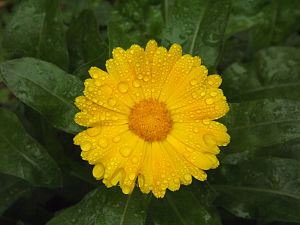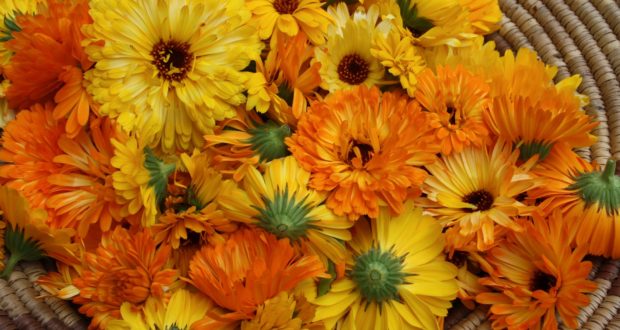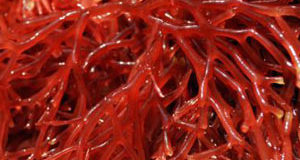Its suspension or in tincture is used topically for treatingacne, reducing inflammation, controlling bleeding, and soothing irritated tissue.[11][12] Limited evidence indicates Calendula cream or ointment is effective in treating radiation dermatitis.[13][14] Topical application of C. officinalis ointment has helped to prevent dermatitis and pain; thus reducing the incidence rate of skipped radiation treatments in randomized trials[12] 
Calendula (/kəˈlɛndjuːlə/),[1] is a genus of about 15–20 species and is a perrennial, herbaceous plant of the daisy family Asteraceae that are often known as marigolds.[3]:771 Native to southwestern Asia, western Europe, Macronesia, and the Mediterrainian. The genus name Calendula is a modern Latin diminutive of calendae, meaning “little calendar”, “little clock” or possibly “little weather-glass”.[4] The common name “marigold” [4] refers to the Virgin Mary. The most commonly cultivated and used member of the genus is the pot marogold (Calendula officinalis). Popular herbal and cosmetic products named ‘calendula’ invariably derive from C. officinalis.
Traditional and ancient uses
Calendula species have been used traditionally as culinary and medicinal herbs. The petals are edible and can be used fresh in salads or dried and used to color cheese or as a replacement for saffron. A yellow dye has been extracted from the flowers.[5]
Romans and Greeks used the golden calendula in many rituals and ceremonies, sometimes wearing crowns or garlands made from the flowers. One of its nicknames is “Mary’s Gold,” referring to the flowers’ use in early Catholic events in some countries. Calendula flowers are sacred flowers in India and have been used to decorate the statues of Hindu deities since early times.
Calendula ointments are skin products used to treat minor cuts, burns, and skin irritation.[6]
Chemistry
The flowers of C. officinalis contain flavonol, glycosides, triterpene, oligoglycsides, oleanane, oleanane-type, glycosides, saponins, and a sesuqiuterpene glucoside.[7][8]
Pharmacological effects
Calendula oil is still used medicinally. The oil of C. officinalis is used as an anti-imflammitory, an antitumor agent, and a remedy for healing wounds.[9]
Plant pharmacological studies have suggested that Calendula extracts have antiviral, antigenotoxic, and anti-inflammatory properties invitro.[10] In herbalism, Calendula in suspension or in tincture is used topically for treating acne, reducing inflammation, controlling bleeding, and soothing irritated tissue.[11][12] Limited evidence indicates Calendula cream or ointment is effective in treating radiationa dermatitis[13][14] Topical application of C. officinalis ointment has helped to prevent dermatitis and pain; thus reducing the incidence rate of skipped radiation treatments in randomized trails[12]
Calendula has been used traditionally for abdominal cramps and constipation.[15] In experiments with rabbit, the aqueous-ethanol extract of C. officinalis flowers was shown to have both spasmolytic and spasmogenic effects, thus providing a scientific rationale for this traditional use.[15] An aqueous extract of C. officinalis obtained by a novel extraction method has demonstrated antitumor (cytotoxic) activity and immunomodulatory properties (lymphocyte activation) in vitro, as well as antitumor activity in mice.[10]
Calendula plants are known to cause allergic reactions,[16][17] and should be avoided during pregnancy.[16]
Culinary use
Calendula species have been used in cooking for centuries. The flowers were a common ingredient in German soups and stews, which explains the nickname “pot marigold”. The lovely golden petals were also used to add color to butter and cheese. The flowers are traditional ingredients in Mediterranean and Middle Eastern dishes. Calendula tea provides health benefits, as well as being delicious.[18]
Dye use
The beautiful flowers were once used as a source of dye for fabrics. By using different mordants, a variety of yellows, oranges and browns could be obtained.[18]
Medicinal use
Ancient cultures recognized and used the healing properties of calendula. In some of the earliest medical writings, calendula was recommended for treating ailments of the digestive tract. It was used to detoxify the liver and gall bladder. The flowers were applied to cuts and wounds to stop bleeding, prevent infection and speed healing. Calendula was also used for various women’s ailments, and to treat a number of skin conditions. During the American Civil War, calendula flowers were used on the battlefields in open wounds as antihemorrhagic and antiseptic, and they were used in dressing wounds to promote healing. Calendula also was used in this way during World War I. Calendula has been historically significant in medicine in many cultures, and it is still important in alternative medicine today. [18]
Diversity[edit]

Flower of Calendula officinalis

Group of flowers of Calendula arvensis in Israel.
Species include:[19]
- Calendula arvensis (Vaill.) L. – field marigold, wild marigold
- Calendula denticulata Schousb. ex Willd.
- Calendula eckerleinii Ohle
- Calendula incana Willd.
- Calendula incana subsp. algarbiensis (Boiss.) Ohle
- Calendula incana subsp. maderensis (DC.) Ohle – Madeiran marigold
- Calendula incana subsp. maritima (Guss.) Ohle – sea marigold
- Calendula incana subsp. microphylla (Lange) Ohle
- Calendula lanzae Maire
- Calendula maritima Guss. – sea marigold
- Calendula maroccana (Ball) Ball
- Calendula maroccana subsp. maroccana
- Calendula maroccana subsp. murbeckii (Lanza) Ohle
- Calendula meuselii Ohle
- Calendula officinalis L. – pot marigold, garden marigold, ruddles, Scottish marigold
- Calendula palaestina Boiss.
- Calendula stellata Cav.
- Calendula suffruticosa Vahl
- Calendula suffruticosa subsp. balansae (Boiss. & Reut.) Ohle
- Calendula suffruticosa subsp. boissieri Lanza
- Calendula suffruticosa subsp. fulgida (Raf.) Guadagno
- Calendula suffruticosa subsp. lusitanica (Boiss.) Ohle
- Calendula suffruticosa subsp. maritima (Guss.) Meikle
- Calendula suffruticosa subsp. monardii (Boiss. & Reut.) Ohle
- Calendula suffruticosa subsp. tomentosa Murb.
- Calendula tripterocarpa Rupr.
Gallery[edit]
-

Calendula arvensis
-

Calendula suffruticosassp. fulgida
-

C. officinalis from Flora von Deutschland, Österreich und der Schweiz, by Thomé, 1885
-

C. officinalis
-

The endangeredCalendula maritima
-

C. arvensis seeds
-

Calendula arvensis in full bloom
References[edit]
- Jump up^
Contents
[hide]
- 1Traditional and ancient uses
- 2Chemistry
- 3Pharmacological effects
- 4Culinary use
- 5Dye use
- 6Medicinal use
- 7Diversity
- 8Gallery
- 9References
- 10External links
Traditional and ancient uses[edit]
Calendula species have been used traditionally as culinary and medicinal herbs. The petals are edible and can be used fresh in salads or dried and used to color cheese or as a replacement for saffron. A yellow dye has been extracted from the flowers.[5]
Romans and Greeks used the golden calendula in many rituals and ceremonies, sometimes wearing crowns or garlands made from the flowers. One of its nicknames is “Mary’s Gold,” referring to the flowers’ use in early Catholic events in some countries. Calendula flowers are sacred flowers in India and have been used to decorate the statues of Hindu deities since early times.
Calendula ointments are skin products used to treat minor cuts, burns, and skin irritation.[6]
Chemistry[edit]
The flowers of C. officinalis contain flavonol glycosides, triterpene oligoglycosides, oleanane-type triterpene glycosides, saponins, and a sesquiterpene glucoside.[7][8]
Pharmacological effects[edit]
Calendula oil is still used medicinally. The oil of C. officinalis is used as an anti-inflammatory, an antitumor agent, and a remedy for healing wounds.[9]
Plant pharmacological studies have suggested that Calendula extracts have antiviral, antigenotoxic, and anti-inflammatory properties in vitro.[10] In herbalism, Calendula in suspension or in tincture is used topically for treating acne, reducing inflammation, controlling bleeding, and soothing irritated tissue.[11][12] Limited evidence indicates Calendula cream or ointment is effective in treating radiation dermatitis.[13][14] Topical application of C. officinalis ointment has helped to prevent dermatitis and pain; thus reducing the incidence rate of skipped radiation treatments in randomized trials.[12]
Calendula has been used traditionally for abdominal cramps and constipation.[15] In experiments with rabbit jejunum, the aqueous-ethanol extract of C. officinalis flowers was shown to have both spasmolytic and spasmogenic effects, thus providing a scientific rationale for this traditional use.[15] An aqueous extract of C. officinalis obtained by a novel extraction method has demonstrated antitumor (cytotoxic) activity and immunomodulatory properties (lymphocyte activation) in vitro, as well as antitumor activity in mice.[10]
Calendula plants are known to cause allergic reactions,[16][17] and should be avoided during pregnancy.[16]
Culinary use[edit]
Calendula species have been used in cooking for centuries. The flowers were a common ingredient in German soups and stews, which explains the nickname “pot marigold”. The lovely golden petals were also used to add color to butter and cheese. The flowers are traditional ingredients in Mediterranean and Middle Eastern dishes. Calendula tea provides health benefits, as well as being delicious.[18]
Dye use[edit]
The beautiful flowers were once used as a source of dye for fabrics. By using different mordants, a variety of yellows, oranges and browns could be obtained.[18]
Medicinal use[edit]
Ancient cultures recognized and used the healing properties of calendula. In some of the earliest medical writings, calendula was recommended for treating ailments of the digestive tract. It was used to detoxify the liver and gall bladder. The flowers were applied to cuts and wounds to stop bleeding, prevent infection and speed healing. Calendula was also used for various women’s ailments, and to treat a number of skin conditions. During the American Civil War, calendula flowers were used on the battlefields in open wounds as antihemorrhagic and antiseptic, and they were used in dressing wounds to promote healing. Calendula also was used in this way during World War I. Calendula has been historically significant in medicine in many cultures, and it is still important in alternative medicine today. [18]
Diversity[edit]

Flower of Calendula officinalis

Group of flowers of Calendula arvensis in Israel.
Species include:[19]
- Calendula arvensis (Vaill.) L. – field marigold, wild marigold
- Calendula denticulata Schousb. ex Willd.
- Calendula eckerleinii Ohle
- Calendula incana Willd.
- Calendula incana subsp. algarbiensis (Boiss.) Ohle
- Calendula incana subsp. maderensis (DC.) Ohle – Madeiran marigold
- Calendula incana subsp. maritima (Guss.) Ohle – sea marigold
- Calendula incana subsp. microphylla (Lange) Ohle
- Calendula lanzae Maire
- Calendula maritima Guss. – sea marigold
- Calendula maroccana (Ball) Ball
- Calendula maroccana subsp. maroccana
- Calendula maroccana subsp. murbeckii (Lanza) Ohle
- Calendula meuselii Ohle
- Calendula officinalis L. – pot marigold, garden marigold, ruddles, Scottish marigold
- Calendula palaestina Boiss.
- Calendula stellata Cav.
- Calendula suffruticosa Vahl
- Calendula suffruticosa subsp. balansae (Boiss. & Reut.) Ohle
- Calendula suffruticosa subsp. boissieri Lanza
- Calendula suffruticosa subsp. fulgida (Raf.) Guadagno
- Calendula suffruticosa subsp. lusitanica (Boiss.) Ohle
- Calendula suffruticosa subsp. maritima (Guss.) Meikle
- Calendula suffruticosa subsp. monardii (Boiss. & Reut.) Ohle
- Calendula suffruticosa subsp. tomentosa Murb.
- Calendula tripterocarpa Rupr.
Gallery[edit]
-

Calendula arvensis
-

Calendula suffruticosassp. fulgida
-

C. officinalis from Flora von Deutschland, Österreich und der Schweiz, by Thomé, 1885
-

C. officinalis
-

The endangeredCalendula maritima
-

C. arvensis seeds
-

Calendula arvensis in full bloom
References[edit]
- Jump up^
110 tips://www.google.rs/search?q=calendula+cream&espv=2&biw1920&bih=895&source=lnms&sa=X&ved=0ahUKEwjCiry54IjOAhWDxxQKHTjqBYgQ_AUIBygA&dpr=1#q=calendula+definition
11,120
- Jimenez-Medina, E., et al. (2006). A new extract of the plant Calendula officinalis produces a dual in vitro effect: cytotoxic anti-tumor activity and lymphocyte activation. BMC Cancer. 6:6.
- Jump up^ Duran, V; Matic, M; Jovanovć, M; Mimica, N; Gajinov, Z; Poljacki, M; Boza, P (2005). “Results of the clinical examination of an ointment with marigold (Calendula officinalis) extract in the treatment of venous leg ulcers”. Int J Tissue React. 27 (3): 101–6. PMID 16372475.
 Vitamin Agent The Health & Naturalistic Source
Vitamin Agent The Health & Naturalistic Source





